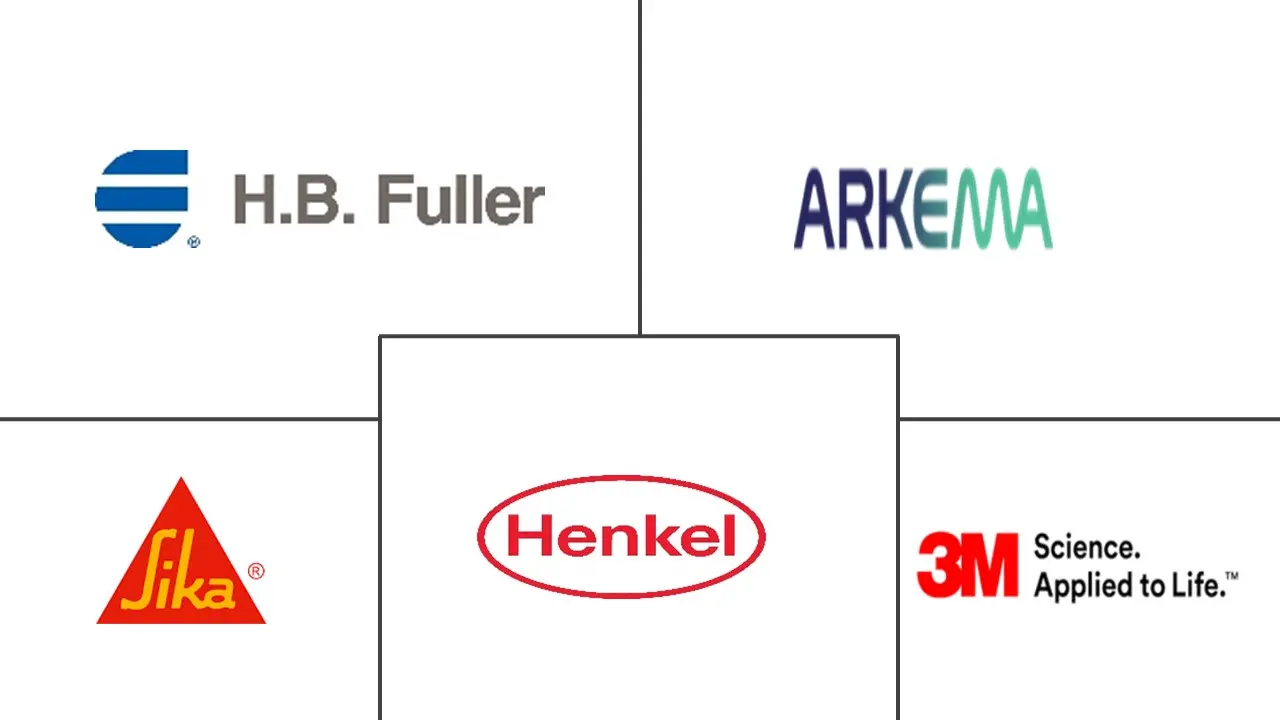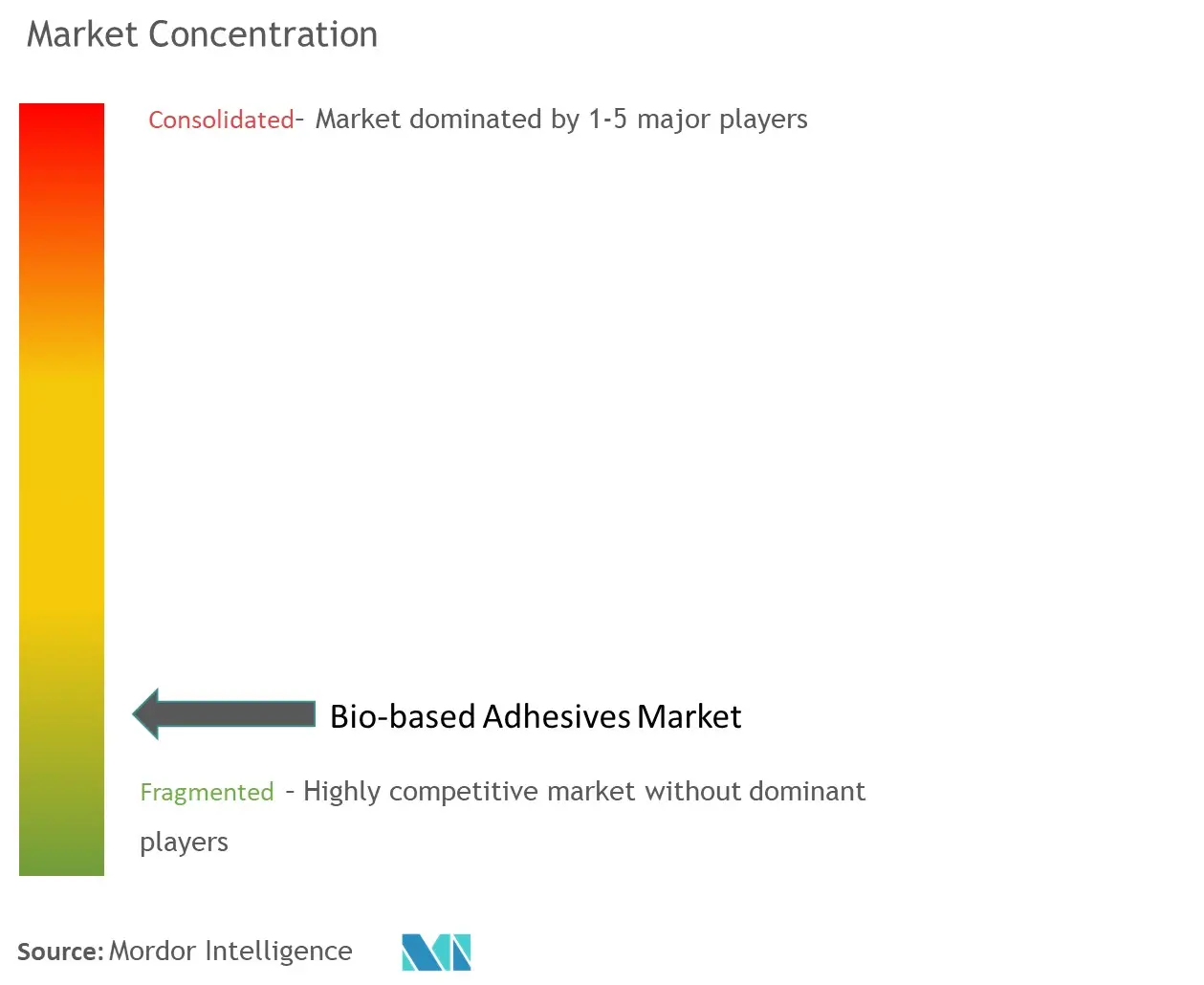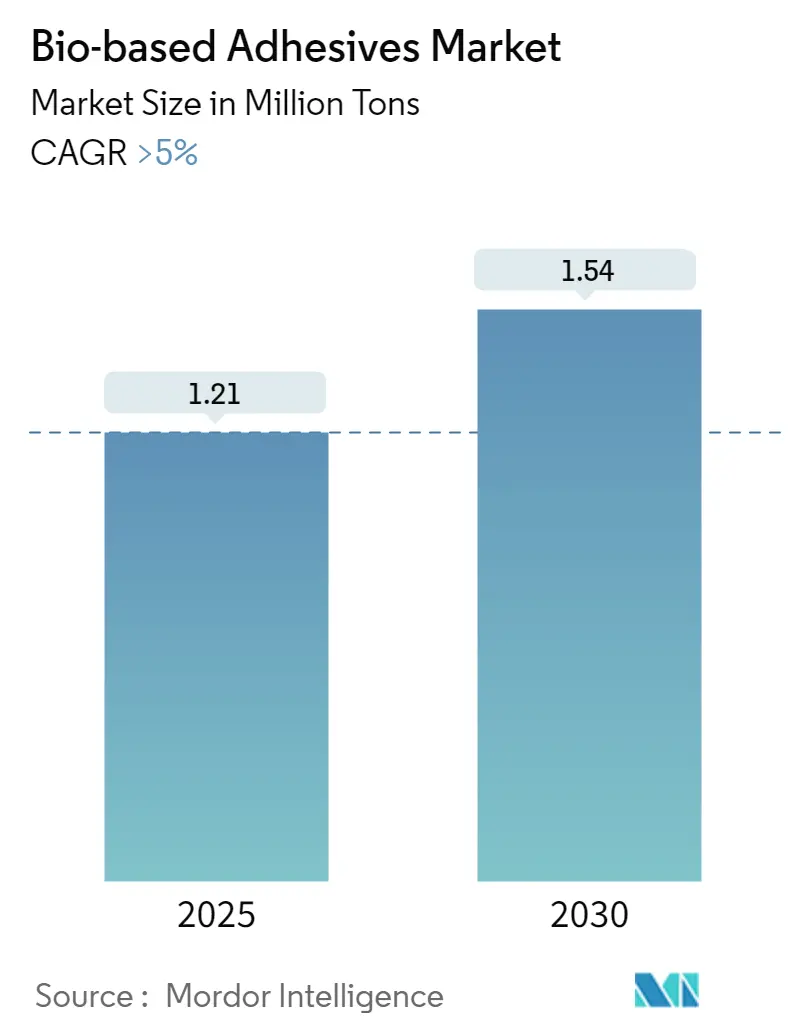
Bio-based Adhesives Market Analysis
The Bio-based Adhesives Market size is estimated at 1.21 million tons in 2025, and is expected to reach 1.54 million tons by 2030, at a CAGR of greater than 5% during the forecast period (2025-2030).
- The increasing demand from the packaging sector and the stringent regulations for conventional adhesives in the United States are two main factors driving the market growth.
- However, the low shelf life and performance hindrance of bio-based additives compared to petroleum-based additives is likely to hinder market growth.
- Nevertheless, the growing modular construction activities are likely to provide growth opportunities for the market over the short term.
- Europe dominates the bio-based adhesives market across the world and is likely to witness the highest growth rate during the forecast period.
Bio-based Adhesives Market Trends
The Packaging Industry is Expected to Dominate the Market
- An extremely high proportion of all industrial products are sold in packaged form, either due to stability requirements for storage and transport or aesthetic reasons. Most of the packaging materials currently being used are made from a combination of different materials laminated together with the help of adhesives.
- Bio-based adhesives are integral to the food and beverage industry, facilitating sustainable packaging, labeling, laminates, edible coatings for extended shelf life, assembly in dairy and beverage processing, compostable packaging, functional applications, and addressing migration concerns, thereby contributing to a greener and more environment-friendly industry.
- As per PMMI (The Association for Packaging and Processing), the North American beverage packaging industry is expected to record a 4.5% growth from 2018 to 2028, with the United States taking a prominent role in advancing the beverage packaging sector.
- The prevalence of services like Amazon Fresh is on the rise, enabling consumers to acquire fresh produce from the comfort of their homes. Additionally, the majority of food and beverage processing plants are centered around bio-based adhesives for the packaging.
- The rising demand for organic food globally is expected to boost the consumption of food packaging. According to the Organic Trade Association, in the United States, organic packaged food is likely to reach a value of USD 25,060.4 million by 2025.
- According to the Packaging Industry Association of India (PIAI), the Indian packaging industry is expected to grow at a rate of 22% during the forecast period. The Indian packaging market is expected to reach USD 204.81 billion by 2025. Therefore, the bio-based adhesives market is expected to grow in the region.
- The improvement in living standards and higher purchasing incomes, especially in Eastern European and North American countries, has increased the demand for a broad range of products, all of which require packaging. Therefore, the demand for packaging has, in turn, increased the consumption of bio-based adhesives.
- Hence, all the aforementioned factors are expected to drive the packaging industry, enhancing the demand for bio-based adhesives during the forecast period.
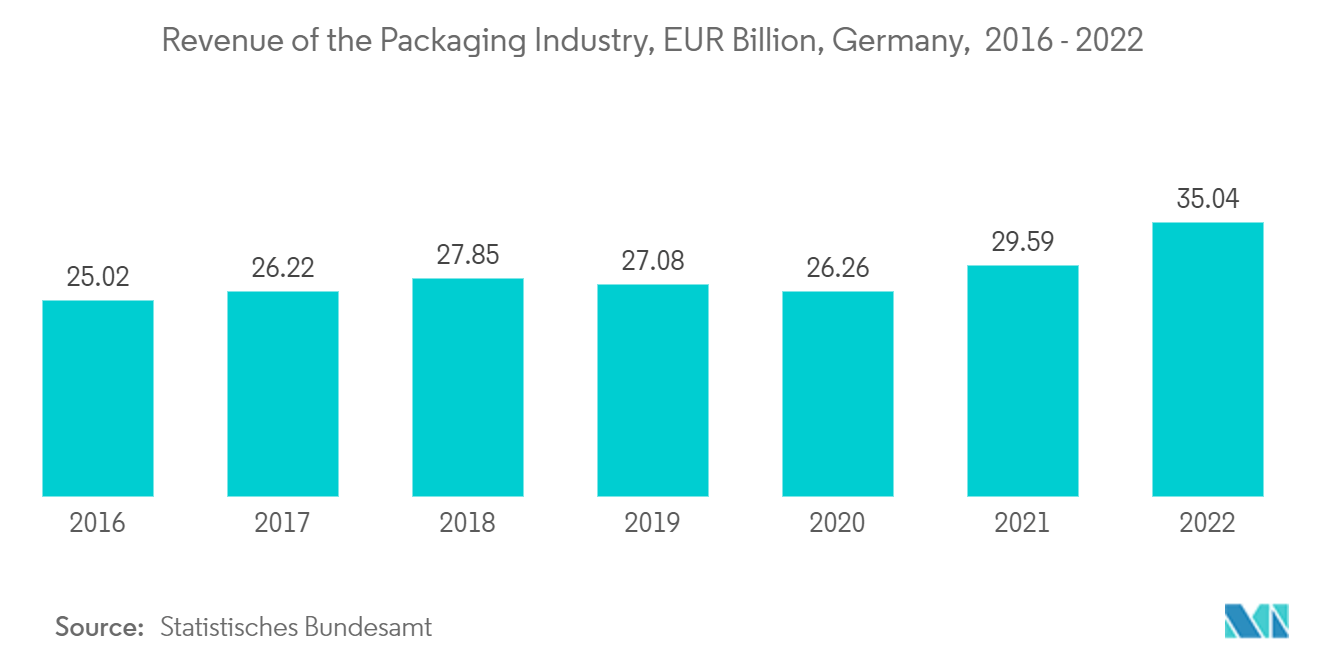
Europe is Expected to Dominate the Market
- Europe dominated the bio-based adhesives market owing to the high demand from countries like Germany and the United Kingdom.
- Germany is the major consumer of bio-based adhesives in Europe, with many major companies having a presence in the country. It is a major producer of natural rubber- and starch-based adhesives in the global scenario.
- The increase in the production of bio-succinic acid in Germany has supported the production of bio-based label adhesives that are based on bio-succinic acid.
- Bio-based adhesives play a pivotal role in the construction industry, being utilized for wood bonding, panel and composite manufacturing, insulation material bonding, eco-friendly flooring installations, construction sealants, prefabricated construction, adhesive tapes, green roofing installations, biodegradable formwork adhesives, and overall sustainable construction practices, contributing to environmentally conscious building processes.
- As per the data released by the European Commission, growth in construction production in December 2023 compared to December 2022 was 1.9% across the euro area and 2.4% across the European Union. The year-on-year average increase in construction production in 2023 compared to 2022 was 0.2% for the euro area and 0.1% for the European Union.
- In the healthcare industry, bio-based adhesives find applications in various medical and pharmaceutical contexts, including wound care, medical device assembly, and drug delivery systems, providing biocompatible and safe bonding solutions.
- According to a new report by the Organisation for Economic Co-operation and Development (OECD), in 2023, Germany was the second-largest spender in healthcare, disbursing 12.7% of its GDP on healthcare, followed by France, which spent around 12.1% of its GDP.
- In the personal care industry, bio-based adhesives are employed in the production of cosmetic and hygiene products, contributing to the assembly of items such as bandages, adhesive tapes, and sanitary products, offering a sustainable and skin-friendly alternative to traditional adhesives.
- According to the Office for National Statistics (UK), consumer spending on personal care in the United Kingdom reached GBP 7,896 million in the first quarter of 2023, increasing from GBP 7,363 million in the first quarter of 2022.
- In Italy, the market for modular construction is expected to grow at a significant rate during the forecast period, with an increase in residential construction activities and various institutional projects. As per Eurostat (a directorate-general of the European Commission), the construction revenue in Italy will reach around USD 57.68 billion by 2025.
- Hence, Europe is likely to dominate the bio-based adhesives market and is expected to hold the largest market share during the forecast period.
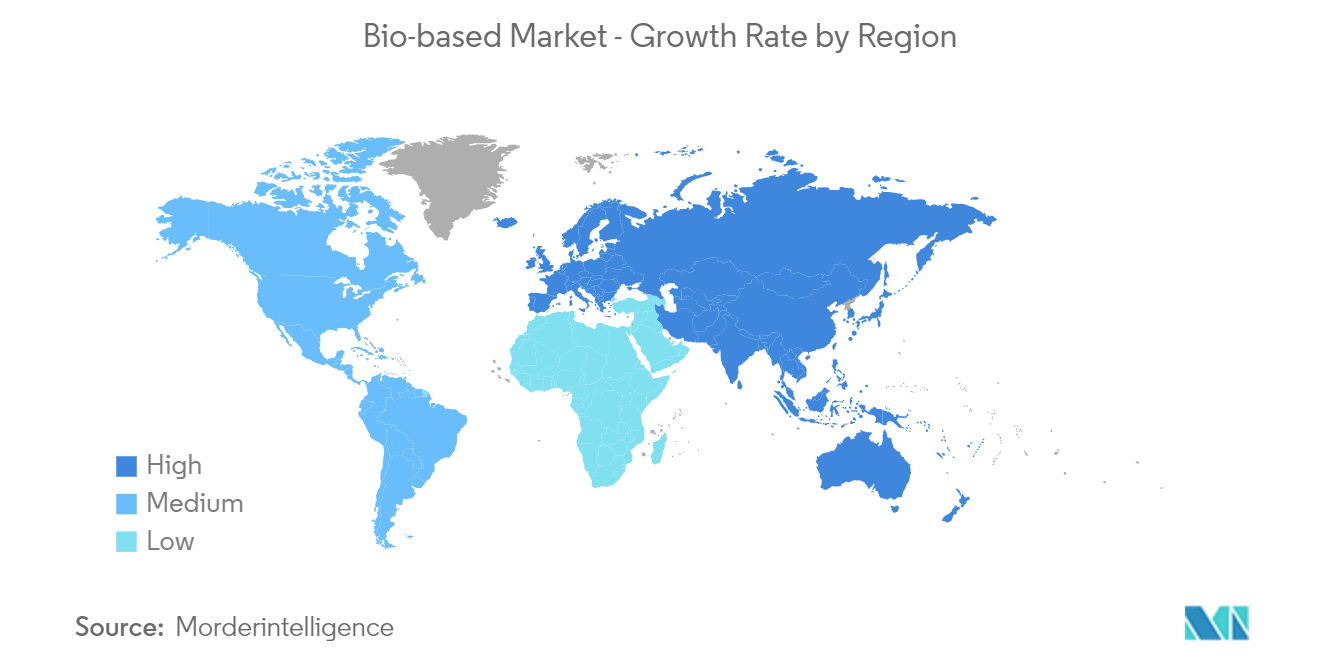
Bio-based Industry Overview
The global bio-based adhesives market is fragmented, with high competition among the key players. Major players operating in the market include Henkel AG & Co. KGaA, H.B Fuller, Arkema, Sika, and 3M company.
Bio-based Market Leaders
-
Henkel AG & Co. KGaA
-
H.B. Fuller Company.
-
3M
-
Arkema
-
Sika
- *Disclaimer: Major Players sorted in no particular order
Bio-based Market News
The recent developments pertaining to the major players in the market are being covered in the complete study.
Bio-based Adhesives Industry Segmentation
Bio-based adhesives are adhesive formulations derived from renewable resources such as plant-based materials, offering an eco-friendly alternative to traditional adhesives that are often petroleum-based. These adhesives are designed to provide bonding properties while minimizing environmental impact; this aligns with sustainability and green manufacturing practices.
The bio-based adhesives market is segmented by raw materials, end-user industry, and geography. By raw materials, the market is segmented by rosin, starch, lignin, and soy (polylactic acid and seaweed). By end-user industry, the market is segmented into building and construction, paper, board, and packaging, healthcare, personal care, woodworking and joinery, and other end-user industries. The report also offers market sizes and forecasts for 27 countries across major regions. For each segment, market sizing and forecasts were made based on volume (kilotons).
| Raw Materials | Rosin | ||
| Starch | |||
| Lignin | |||
| Soy | |||
| Other Raw Materials | |||
| End-user Industry | Building and Construction | ||
| Paper and Board Packaging | |||
| Healthcare | |||
| Personal Care | |||
| Woodworking and Joinery | |||
| Other End-user Industries | |||
| Geography | Asia-Pacific | China | |
| India | |||
| Japan | |||
| South Korea | |||
| Rest of Asia-Pacific | |||
| North America | United States | ||
| Canada | |||
| Mexico | |||
| Europe | Germany | ||
| United Kingdom | |||
| France | |||
| Italy | |||
| Rest of Europe | |||
| South America | Brazil | ||
| Argentina | |||
| Rest of South America | |||
| Middle East and Africa | Saudi Arabia | ||
| South Africa | |||
| Rest of Middle East and Africa | |||
Bio-based Adhesives Market Research FAQs
How big is the Bio-based Adhesives Market?
The Bio-based Adhesives Market size is expected to reach 1.21 million tons in 2025 and grow at a CAGR of greater than 5% to reach 1.54 million tons by 2030.
What is the current Bio-based Adhesives Market size?
In 2025, the Bio-based Adhesives Market size is expected to reach 1.21 million tons.
Who are the key players in Bio-based Adhesives Market?
Henkel AG & Co. KGaA, H.B. Fuller Company., 3M, Arkema and Sika are the major companies operating in the Bio-based Adhesives Market.
Which is the fastest growing region in Bio-based Adhesives Market?
Asia Pacific is estimated to grow at the highest CAGR over the forecast period (2025-2030).
Which region has the biggest share in Bio-based Adhesives Market?
In 2025, the Europe accounts for the largest market share in Bio-based Adhesives Market.
What years does this Bio-based Adhesives Market cover, and what was the market size in 2024?
In 2024, the Bio-based Adhesives Market size was estimated at 1.15 million tons. The report covers the Bio-based Adhesives Market historical market size for years: 2019, 2020, 2021, 2022, 2023 and 2024. The report also forecasts the Bio-based Adhesives Market size for years: 2025, 2026, 2027, 2028, 2029 and 2030.
Our Best Selling Reports
Bio-based Adhesives Industry Report
Statistics for the 2025 Bio-based Adhesives market share, size and revenue growth rate, created by Mordor Intelligence™ Industry Reports. Bio-based Adhesives analysis includes a market forecast outlook for 2025 to 2030 and historical overview. Get a sample of this industry analysis as a free report PDF download.

